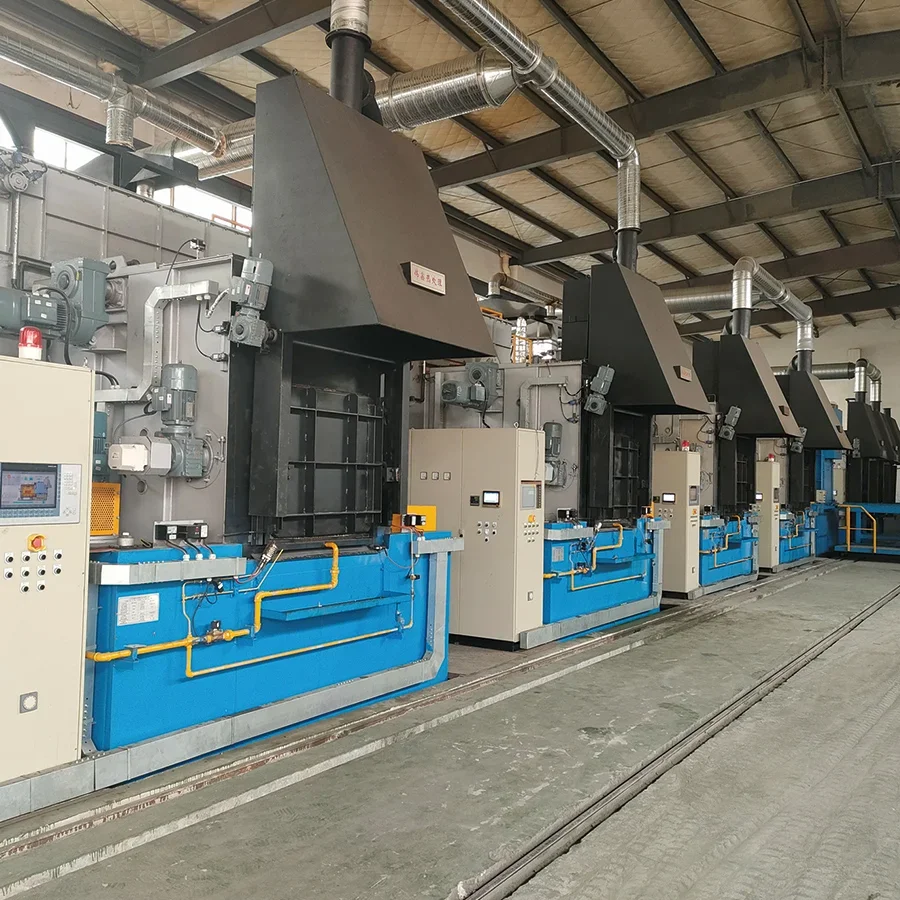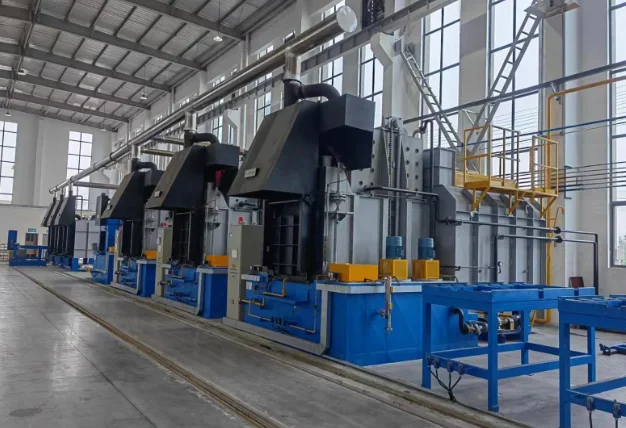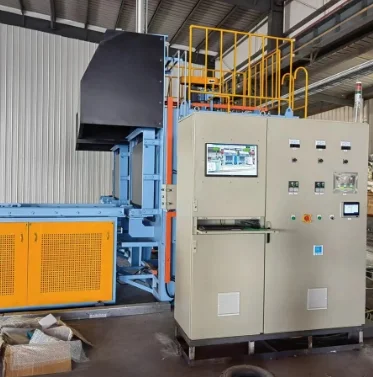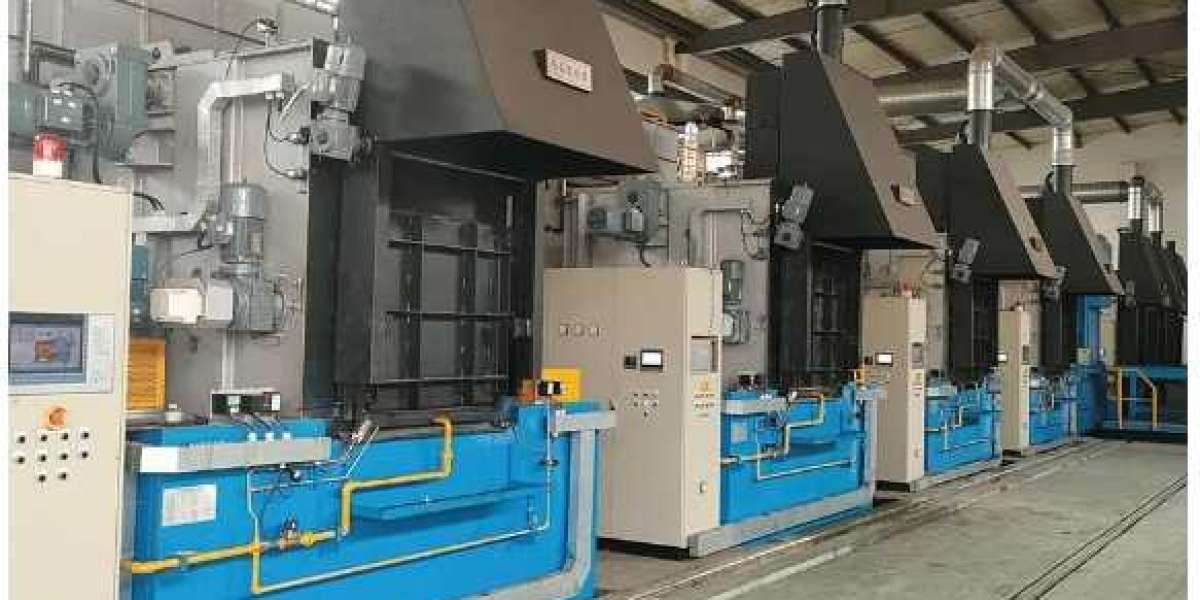A tempering furnace plays a crucial role in heat treatment processes, enhancing the mechanical properties of materials like steel. By subjecting metal to controlled heating and cooling cycles, tempering furnaces relieve internal stresses, improve toughness, and reduce brittleness. These furnaces ensure uniform heating for consistent results, making them indispensable in industries requiring precise material characteristics. Understanding the significance of temperature control and timing is key to achieving desired material properties with a tempering furnace.
Understanding the Tempering Process
Definition of Tempering
Tempering is a crucial heat treatment process in metalworking that involves heating and cooling to alter the properties of iron-based metals. It enhances ductility and toughness while reducing hardness.
The tempering process is vital for achieving the desired balance between hardness and flexibility in metal products. By subjecting the metal to specific temperatures, it helps in relieving internal stresses and improving its overall mechanical properties.
Key Steps in Tempering Iron-Based Metal Products
Heating: The metal is heated to a specific temperature based on the type of material and desired outcome.
Holding: Once the correct temperature is reached, the metal is held at that temperature to ensure uniform heat distribution.
Cooling: The metal is then cooled gradually in a controlled manner, which determines its final properties.
During tempering, it's essential to monitor the temperature carefully to prevent overheating or underheating, as this can result in undesirable changes to the metal's structure.
Temperature Ranges Used in the Tempering Process
Low Temperatures (200-400°C): Result in increased ductility and toughness while maintaining moderate hardness.
Medium Temperatures (400-600°C): Strike a balance between strength and ductility, ideal for many engineering applications.
High Temperatures (above 600°C): Lead to significant softening of the metal, suitable for parts requiring extreme flexibility.
Controlling the temperature precisely during tempering is critical for achieving consistent results across batches of metal products. This ensures uniformity in mechanical properties and structural integrity.
How Tempering Enhances Material Properties
Toughness Enhancement
Tempering significantly enhances the toughness of ferrous metal products. By subjecting the material to a specific temperature range, it relieves internal stresses and improves ductility. This process helps prevent sudden fractures and increases the material's ability to deform before breaking.
Reduction of Strength and Brittleness
Tempering plays a crucial role in reducing the strength and brittleness of metals to desired levels. This process, after the initial hardening, allows for controlled softening by heating the metal to a lower temperature. As a result, the metal becomes less brittle while maintaining adequate strength levels.
Impact on Mechanical Properties
During tempering, changes occur in the material's microstructure, influencing its mechanical properties. The process involves heating the metal to a specific temperature followed by controlled cooling. This alters the hardness, strength, and ductility of the material, making it more suitable for various applications.
Exploring Different Types of Tempering Furnaces
Electric Furnaces
Electric furnaces are commonly used for oven modification in the tempering process. They operate by heating metal components using electrical resistance. This type of furnace offers precise temperature control, making it ideal for tempering various metals.
One of the key advantages of electric furnaces is their ability to provide uniform heating throughout the entire workpiece. This results in consistent hardness and strength properties across the metal component being tempered.
Gas Furnaces
Gas furnaces utilize metal combustion to generate heat for the tempering process. They are known for their high heating rates, making them efficient for quick tempering cycles. Gas furnaces are often preferred for large-scale industrial applications due to their robust performance.
Compared to electric furnaces, gas furnaces can reach higher temperatures more rapidly, reducing overall processing times. However, they may require more extensive safety measures due to the use of combustible gases.
Salt Bath Furnaces
Salt bath furnaces immerse metal components in a bath of molten salts for tempering. This method offers rapid and uniform heating, resulting in excellent control over the tempering process. Salt bath furnaces are particularly effective for achieving specific hardness levels in metals.
One significant advantage of salt bath furnaces is their ability to prevent oxidation during the heating process. The molten salt creates a protective atmosphere around the metal, minimizing surface reactions that could affect its properties.
Induction Furnaces
Induction furnaces use electromagnetic induction to heat metal components quickly and efficiently. They offer precise temperature control and energy efficiency, making them suitable for a wide range of tempering applications. Induction technology is often favored for its versatility and adaptability to different metal types.
Induction furnaces are known for their rapid heating rates and minimal heat loss during operation. This results in shorter cycle times and reduced energy consumption compared to other furnace types.

Bench-Top Furnaces Overview
Characteristics
Bench-top furnaces, used for tempering, are compact and versatile, ideal for small-scale operations in research or laboratory settings. These furnaces are designed to heat materials uniformly at controlled temperatures.
Bench-top tempering furnaces are equipped with advanced flat glass technology that ensures precise heating and cooling processes. They offer a reliable source of heat, ensuring consistent results in material tempering applications.
Functionality
These furnaces operate efficiently, utilizing cutting-edge technology to achieve optimal tempering results. The year description of bench-top furnaces indicates their modern design and enhanced capabilities compared to traditional models.
The year advancements in bench-top furnace technology have significantly reduced the processing duration, making them a time-efficient solution for various tempering requirements. The integration of innovative features allows for easy operation and maintenance.
Suitability for Smaller-Scale Operations
Bench-top furnaces are particularly well-suited for smaller-scale tempering tasks due to their compact size and precise temperature control capabilities. For individuals or organizations conducting limited youtube videos on material tempering processes, these furnaces offer a convenient and efficient solution.
Their compact design makes them perfect for laboratories or research facilities where space may be limited. Despite their smaller size, bench-top tempering furnaces deliver high-performance results comparable to larger industrial models.
Benefits in Research Settings
The use of bench-top furnaces in research or laboratory environments offers several advantages. Researchers can conduct experiments with greater control over the tempering process, leading to more accurate data collection and analysis.
Incorporating bench-top furnaces into research projects provides researchers with the flexibility to adjust parameters easily based on specific requirements. This adaptability is crucial when studying the effects of different heating and cooling rates on materials.
Pit Furnaces in Detail
Design Overview
Pit furnaces, commonly used for tempering metal components, incorporate a unique design where the heating elements are placed at the bottom of a deep pit. The furnace operates by heating the metal parts within a vacuum or controlled atmosphere environment to prevent oxidation. This design ensures efficient heat transfer and uniform heating throughout the metal components.
The configurations of pit furnaces can vary based on the specific application requirements. They may include multiple heating elements strategically positioned to provide consistent heat distribution. These furnaces can be equipped with advanced control units to regulate temperature accurately.
Working Principles
Pit furnaces operate by placing metal components inside the deep pit, allowing them to be heated evenly from all sides. The elements responsible for generating heat are located at the bottom of the pit, ensuring that the metal parts receive consistent heating without any cold spots. As a result, pit furnaces offer precise control over the tempering process.
One of the key advantages of using pit furnaces for tempering larger metal components is their ability to accommodate various sizes and shapes of parts. Unlike bench-top furnaces, pit furnaces can easily handle oversized or irregularly shaped items due to their spacious design.
Uniform Heating and Cooling
Pit furnaces excel in providing uniform heating and cooling cycles, which are essential for achieving consistent results in metal tempering processes. By maintaining a controlled atmosphere within the furnace, operators can ensure that all parts undergo the same heat treatment conditions, resulting in uniform hardness and strength across the entire batch of components.
Advantages:
Accommodates various sizes and shapes of metal components.
Offers precise control over temperature regulation.
Box Furnaces Explained
Chamber Designs
Box tempering furnaces, unlike pit furnaces, feature a rectangular chamber design. This design allows for easy loading and unloading of metal parts. The insulation lining within the chamber ensures optimal heat retention during the tempering process.
Box furnaces are known for their versatility in accommodating various metal shapes and sizes. They can handle small intricate components as well as large industrial parts. The uniform heat distribution within the chamber guarantees consistent results across all pieces being tempered.
Efficiency and Temperature Control
One significant advantage of box furnaces is their efficiency in heating and cooling cycles. These furnaces are equipped with advanced temperature control systems that maintain precise heat levels throughout the process. This ensures that the metals are tempered to exact specifications without any overheating or under-heating issues.
The temperature control features of box furnaces make them ideal for tempering a wide range of metals, from steel to aluminum alloys. Operators have the flexibility to adjust the temperature settings based on the material being processed, ensuring optimal hardness and strength levels in the finished products.

Draw Furnaces Uncovered
Precision Control
Draw tempering furnaces are vital in the realm of ferrous metal processing, offering specialized functions that ensure precise temperature control during the tempering process. These furnaces play a crucial role in achieving the desired mechanical properties in metals by carefully regulating the heating and cooling cycles.
The draw furnace's design allows for uniform heating of ferrous metals, promoting consistency in their microstructure and hardness. By controlling the rate at which the metal is cooled after heating, these furnaces enable manufacturers to tailor the material's properties to meet specific requirements, such as strength, toughness, and ductility.
Industrial Applications
Industries dealing with ferrous metals rely on draw tempering furnaces to produce high-quality products with exceptional mechanical characteristics. These furnaces find extensive use in sectors like automotive manufacturing, aerospace engineering, and tool production. For instance, in automotive applications, draw furnaces are instrumental in enhancing the strength and durability of critical components like engine parts and chassis elements.
Pros:
Ensures precise temperature control
Facilitates customization of material properties
Enhanced Product Quality
Draw tempering furnaces contribute significantly to improving product quality by allowing manufacturers to achieve specific metallurgical outcomes through controlled heat treatment processes. By utilizing these furnaces, companies can enhance the overall performance of their products while ensuring consistency and reliability in their materials.
Features and Benefits for Industrial Use
Key Features
Industrial tempering furnaces come with automation features, allowing for precise temperature control and consistent heat distribution. These furnaces are designed to accommodate numerous sizes of metal components, providing flexibility in production. They are equipped with advanced aluminum heating elements that ensure uniform heating throughout the process.
Benefits
Enhanced Product Quality: Tempering furnaces play a crucial role in enhancing the toughness and strength of metal products, resulting in improved durability and performance.
Increased Efficiency: By utilizing tempering furnaces, industrial operations can achieve higher levels of efficiency due to quicker turnaround times and reduced energy consumption.
Quality Assurance: These furnaces contribute to maintaining consistent product quality by minimizing variations in the tempering process.
Contribution to Product Quality and Efficiency
Industrial tempering furnaces significantly contribute to the overall quality and efficiency of large-scale metal production processes. By subjecting metal components to controlled heating and cooling cycles, these furnaces impart essential properties such as toughness and strength, ensuring that the final products meet stringent quality standards.
The precise temperature control offered by tempering furnaces results in uniform microstructures within the metal, eliminating any potential weak spots or defects. This meticulous process leads to products with enhanced mechanical properties, making them ideal for demanding industrial applications where reliability is paramount.
Moreover, the use of tempering furnaces streamlines production workflows by reducing manual intervention and optimizing cycle times. This not only boosts operational efficiency but also allows manufacturers to meet tight deadlines without compromising on product quality.
In essence, industrial tempering furnaces serve as indispensable tools in the realm of large-scale metal production, offering a perfect blend of cutting-edge technology, precision engineering, and unmatched reliability.
Selecting the Right Tempering Furnace
Industrial Settings
When selecting a tempering furnace for industrial use, it is crucial to consider the specific requirements of different settings. For heavy-duty applications such as automotive or aerospace industries, opt for furnaces with higher temperature capabilities and larger capacity. In contrast, smaller-scale operations like tool and die shops may benefit from compact furnaces with precise temperature control.
Factors Consideration
Temperature Range: Ensure the furnace can reach and maintain the required temperature range for the metal being processed.
Heating Rate: Consider the heating rate of the furnace to meet production demands efficiently.
Uniformity: Look for furnaces that offer uniform heating to prevent inconsistencies in the final product.
Energy Efficiency: Opt for furnaces with energy-efficient features to reduce operating costs over time.
Automation: Evaluate whether automated controls are necessary for streamlining operations and ensuring consistent results.
In high-volume manufacturing plants, a continuous tempering furnace with conveyor belts may be ideal for seamless production flow. However, custom fabricators dealing with unique metal alloys might prefer batch furnaces that allow for more specialized treatments on smaller batches of parts.
Matching Specifications
Matching tempering furnace specifications with specific metalworking needs involves understanding the material properties and desired outcomes. For instance, when working with stainless steel components requiring precise hardness levels, a furnace with accurate temperature control and quenching capabilities is essential.
For heat treatment processes like annealing or stress relieving, select a furnace that offers programmable cycles to achieve optimal results.
When dealing with sensitive materials prone to distortion or cracking, choose a furnace equipped with protective atmospheres or vacuum capabilities to maintain part integrity during heat treatment.

Closing Thoughts
In conclusion, understanding the tempering process and the various types of tempering furnaces is crucial for industries seeking to enhance material properties effectively. Bench-top, pit, box, and draw furnaces each offer unique features and benefits that cater to diverse industrial needs. Selecting the right tempering furnace demands careful consideration of these factors to optimize the tempering outcomes.
For those venturing into the realm of tempering furnaces, thorough research and consultation with experts are recommended to make informed decisions. By delving deep into the specifics of each furnace type and aligning them with production requirements, businesses can elevate their material processing capabilities significantly.
Frequently Asked Questions
How does the tempering process work?
Tempering involves heating metal to a specific temperature and then cooling it rapidly. This process helps reduce hardness and brittleness while improving toughness and ductility.
What are the key benefits of using a tempering furnace?
Tempering furnaces help enhance material properties, such as strength, toughness, and ductility. They also provide precise control over the tempering process for consistent results.
What types of tempering furnaces are available for industrial use?
Industrial tempering furnaces come in various types like bench-top furnaces, pit furnaces, box furnaces, and draw furnaces. Each type offers unique features suited for different applications.
How should one select the right tempering furnace for their industrial needs?
When selecting a tempering furnace, factors to consider include the type of materials being processed, required temperature range, production capacity, energy efficiency, and budget constraints.
Why is it important to understand different types of tempering furnaces?
Understanding different types of tempering furnaces allows industries to choose the most suitable equipment based on their specific requirements, ensuring optimal performance and quality in the tempering process.







